September 11 terrorist attacks, also called 9/11, were the worst acts of terrorism ever carried out against the United States. On Tuesday, Sept. 11, 2001, terrorists hijacked four commercial jetliners and crashed two of them into the twin towers of the World Trade Center in New York City, and one into the Pentagon Building near Washington, D.C. Hijackers crashed the fourth jet in a Pennsylvania field to prevent it from being reclaimed by passengers. The attacks killed about 3,000 people, including the 19 hijackers.

The U.S. government linked the attacks to al-Qa`ida (also spelled al-Qaeda), an Islamic extremist group founded by the Saudi-born millionaire Osama bin Laden. Bin Laden had previously issued a fatwa (religious edict) calling for Muslims to kill Americans, and al-Qa`ida—which means the base in Arabic—had targeted U.S. interests on several occasions. It attacked U.S. military housing in Saudi Arabia in 1996, U.S. embassies in Kenya and Tanzania in 1998, and the U.S. Navy warship Cole in Yemen in 2000. Al-Qa`ida sought to drive U.S. forces from Saudi Arabia—home to Mecca and Medina, the holy cities of Islam—and from other parts of the Persian Gulf region. Many scholars believe that the group hoped to unite the Islamic world against the United States and its allies and to establish a worldwide society of Muslims governed by Shari`ah (strict Islamic law). The Taliban regime of Afghanistan hosted al-Qa`ida from 1996 until the overthrow of the regime in 2001.
Shortly after the 9/11 attacks, U.S. President George W. Bush addressed a joint session of Congress to declare a “global war on terrorism.” In the nationally televised speech, Bush stated that the United States would target terrorist organizations and any government that harbored or supported them. In keeping with this policy, the United States launched a military campaign against the Taliban in Afghanistan. The support of U.S. forces enabled an alliance of Afghan rebel groups to overthrow the Taliban in December 2001. Numerous members of al-Qa`ida were captured or killed during the fighting in Afghanistan. However, many others, including bin Laden, escaped across the border to a largely ungoverned region of neighboring Pakistan.
The 9/11 attacks have had a powerful impact on the government policies of the United States and many other countries. Counterterrorism measures (efforts to fight terrorism) have become a top priority worldwide. In 2002, the U.S. government established a new executive department, the Department of Homeland Security, to coordinate efforts to prepare for, detect, respond to, and recover from terrorist activity. The government also took steps to improve security in airports and on airplanes, to increase the power of law enforcement, to address security threats from abroad, and to strengthen the nation’s intelligence (information-gathering) services.
The attacks
On the morning of Sept. 11, 2001, the 19 Qa`ida terrorists hijacked four commercial airplanes that had departed within about 40 minutes of one another from three East Coast airports. The terrorists chose flights bound for California because the aircraft carried large quantities of fuel. The terrorists smuggled box-cutters—small tools with sharp blades—onto the planes and seized each aircraft shortly after departure. On three of the four planes, the passengers and crew did not resist, probably believing that they would be held for ransom and eventually released. However, the hijackers murdered the pilots, took control of the planes, and intentionally crashed the planes into their targets.
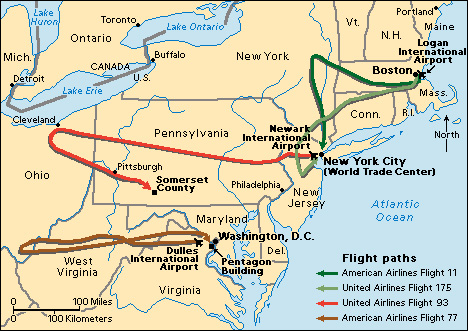
The World Trade Center.
American Airlines Flight 11, bound for Los Angeles, took off from Boston’s Logan International Airport at about 8 a.m. (All times of day in this article are in Eastern Daylight Time.) There were 92 people aboard. Soon afterward, at a nearby gate, United Airlines Flight 175 left for Los Angeles with 65 people.

At about 8:45 a.m., the hijackers crashed Flight 11 into the north tower of the World Trade Center. Less than 20 minutes later, their comrades flew Flight 175 into the south tower. The 110-story twin towers ranked among the world’s tallest skyscrapers and were the most famous part of the World Trade Center, a complex of seven buildings. A symbol of American economic might, the World Trade Center contained offices of a number of U.S. government agencies and many businesses and organizations involved in finance and international trade. About 50,000 people worked in the complex.
As flames and smoke engulfed the towers, people raced to escape the buildings as police, fire, and medical personnel rushed to the site. About an hour after being struck, the south tower collapsed. The north tower collapsed about a half-hour later. Other buildings in the area were also destroyed or heavily damaged. The attacks left about 2,800 people dead or missing, including 157 on the two hijacked planes.
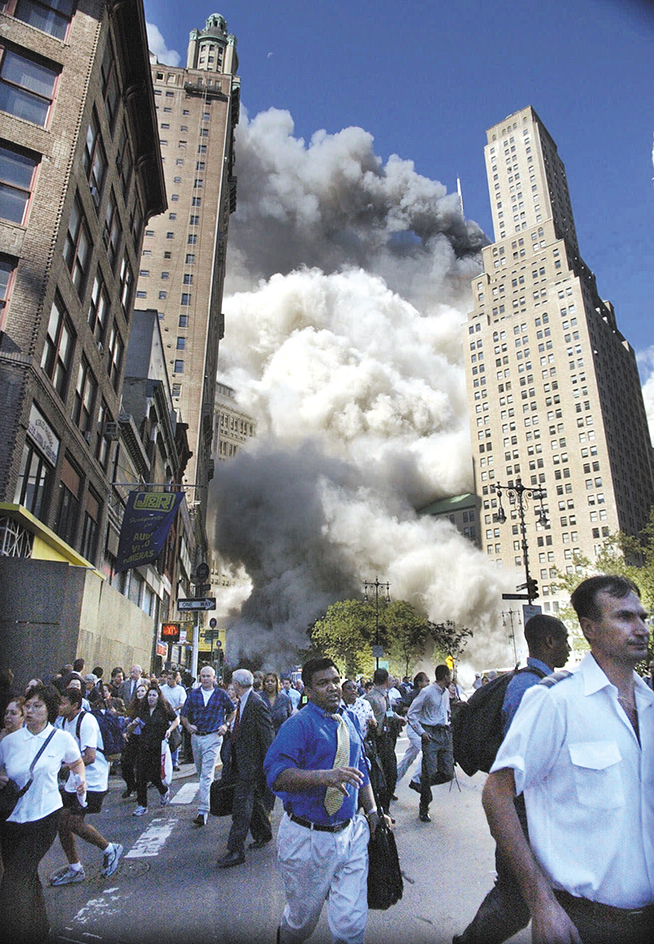
The Pentagon.
At about 8:20 a.m., American Airlines Flight 77 left Washington Dulles International Airport in Virginia for Los Angeles. It carried 58 people. Just over an hour later, Flight 77 crashed into the west side of the Pentagon Building, the nation’s military headquarters near Washington, D.C. A section of the building collapsed shortly afterward, leaving 189 people dead or missing, including the people on the plane.
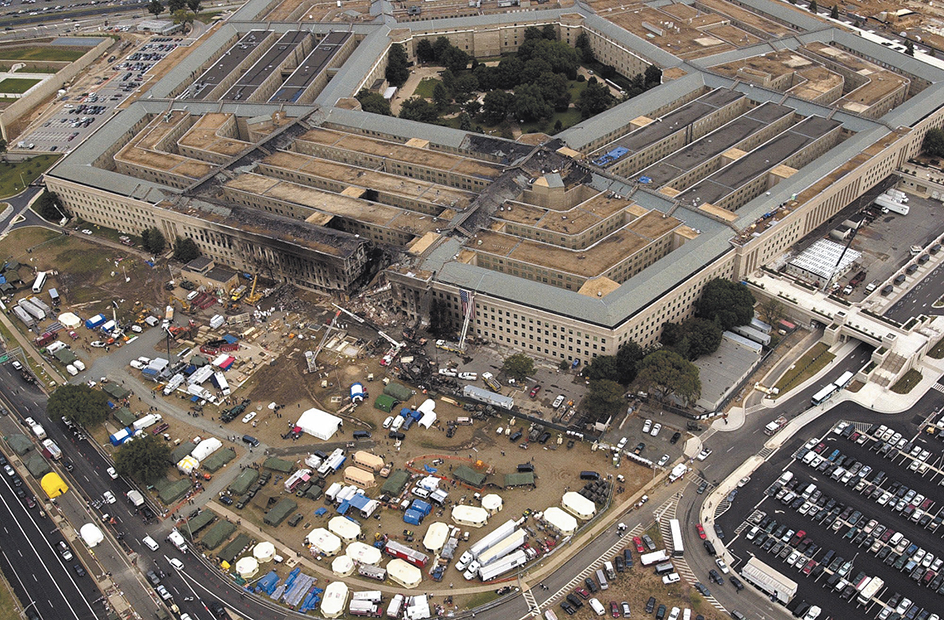
Pennsylvania.
United Airlines Flight 93 left Newark International Airport at about 8:40 a.m., headed for San Francisco. There were 44 people on the plane. Shortly after 10 a.m., the flight crashed in a field in Somerset County in southwestern Pennsylvania. Everyone on the plane was killed.
Telephone calls made by passengers and crew on the plane enabled investigators to reconstruct the events that led up to the crash. After the hijacking, the passengers learned of the other attacks and attempted to regain control of the plane. Afraid the passengers might succeed, the hijackers then crashed the plane into a field. Authorities believe the terrorists had planned to crash the plane into the White House or the U.S. Capitol in Washington, D.C.
The aftermath
Fearful of additional attacks, officials in Washington, D.C., evacuated the White House and offices of the federal government. They grounded all regular air traffic over the United States and arranged for fighter aircraft to fly combat patrols over cities. The major U.S. stock exchanges stopped trading, and many businesses and public landmarks closed early and sent employees home. In a televised speech that evening, President Bush declared, “Today, our nation saw evil.” He said, “These acts of mass murder were intended to frighten our nation into chaos and retreat. But they have failed; our country is strong.”
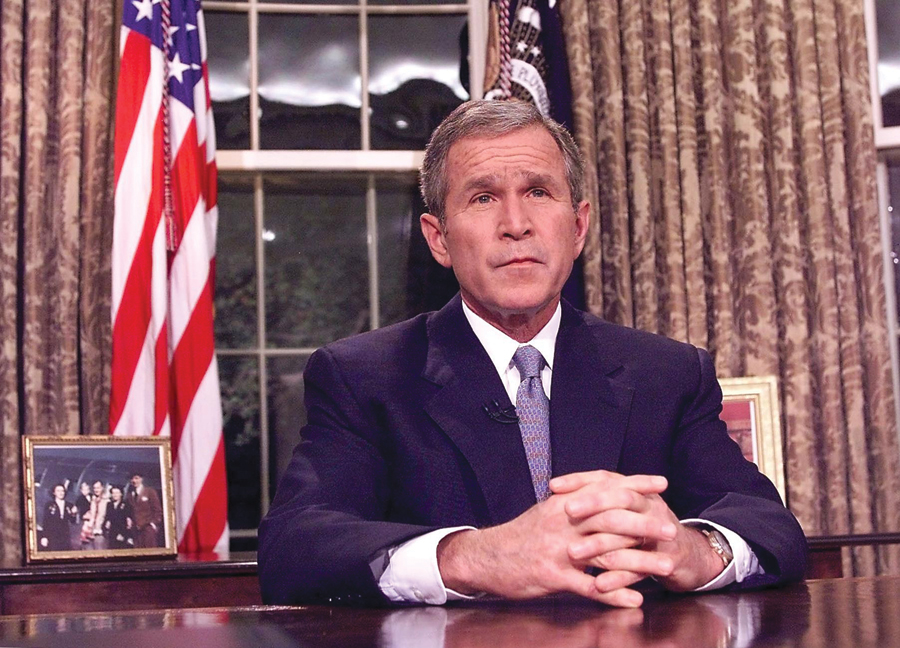
In the weeks and months that followed, the U.S. government moved quickly to identify and punish those responsible for the attacks. Government leaders also took steps to protect U.S. borders, to secure potential terrorist targets around the country, and to safeguard essential services and facilities.
Global war on terrorism.
On Sept. 20, 2001, President Bush addressed the American people and both houses of Congress to declare a “global war on terrorism.” He warned that the struggle would be long but promised that the United States was committed to eliminating the terrorist threat. Bush declared that the United States would take preemptive (preventive) military action against any government that harbored, sponsored, or supported terrorists. This warning was clearly directed at the Taliban regime of Afghanistan.
Investigators quickly determined that Osama bin Laden and his al-Qa`ida terrorist network—which had headquarters and terrorist training camps in Afghanistan—were responsible for the 9/11 attacks. President Bush called upon the Taliban rulers of Afghanistan to turn over bin Laden and to close down the camps. When the Taliban refused, U.S. forces prepared to invade the country. The United States had little difficulty mustering international support for the war. The North Atlantic Treaty Organization (NATO) declared that the 9/11 attacks on the United States had been attacks on the entire alliance. Most NATO member states provided support to the U.S.-led coalition.
On October 7, the United States and its allies launched a military campaign in Afghanistan against the Taliban and al-Qa`ida. Central Intelligence Agency operatives and Special Forces units from the United States strengthened the Northern Alliance, an association of Afghan tribes that opposed the Taliban. Coalition forces launched precision air strikes in support of the alliance, enabling it to overthrow the Taliban in December. After the fall of the Taliban, the United Nations brought together representatives of Afghanistan’s leading factions to develop a plan for a new government. 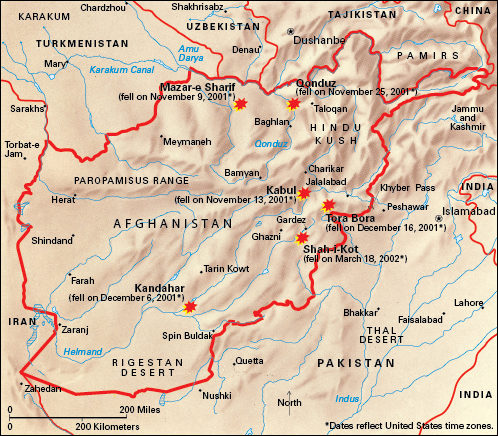
The U.S.-led coalition captured or killed many members of al-Qa`ida during the fighting in Afghanistan. In January 2002, the United States began holding suspected terrorists at a detention center at the U.S. naval base at Guantánamo Bay in Cuba.
Other Qa`ida leaders and associates were captured at different times and locations. Weeks before 9/11, Zacarias Moussaoui, a French citizen of Moroccan descent, was arrested in the United States on immigration charges. Many people believe that he would have been the “20th hijacker” in the attacks if he had not been arrested. In April 2005, Moussaoui pleaded guilty to conspiring with the hijackers and was sentenced to life in prison. Another key figure in the attacks, Khalid Shaikh Mohammed, was arrested in Pakistan in 2003. Mohammed later confessed to being a key planner of the attacks and to coordinating numerous other terrorist acts. For years, efforts to locate and capture bin Laden were unsuccessful. In May 2011, however, a team of U.S. Navy SEALs shot and killed bin Laden during a nighttime helicopter raid on the terrorist leader’s compound in northern Pakistan.
Since 9/11, many experts have criticized the idea of a “global war on terrorism.” They maintain that the concept places too much emphasis on purely military means of confronting terrorism. Many people questioned the wisdom of the U.S. decision to invade Iraq in 2003. The U.S. government claimed that the Iraqi government of Saddam Hussein supported terrorists and could potentially provide them with weapons of mass destruction—that is, chemical, biological, and nuclear weapons. The invasion quickly toppled Hussein’s government, but a lengthy period of fighting between U.S.-led forces and militant groups in Iraq followed (see Iraq War ).
Protecting the homeland.
In mid-September 2001, President Bush announced the creation of a federal Office of Homeland Security to oversee the protection of the United States. In November 2002, Congress expanded the Office of Homeland Security into a new executive department. The Department of Homeland Security brought together a number of agencies involved in various aspects of national security. Such agencies include the Federal Emergency Management Agency, the Transportation Security Administration, the U.S. Coast Guard, the U.S. Secret Service, and agencies responsible for customs, border, and immigration controls. Some experts, however, have questioned whether new bureaucracies (systems of agencies) have actually improved national security.
In October 2001, Congress passed the USA Patriot Act, which expanded the government’s powers of surveillance, investigation, and detention of suspects in the fight against terrorism. The law gave authorities greater freedom to conduct searches of people’s homes and automobiles, to monitor telephone calls and e-mail, and to access information from library, bank, and medical records. It also allowed authorities to detain, in some cases indefinitely, any noncitizen suspected of posing a threat to national security. Many people raised serious concerns over the Patriot Act’s provisions. Critics argued that the law threatened civil liberties and violated constitutional protections against unreasonable searches and seizures. When Congress renewed the act in 2006, it included new safeguards for civil liberties.
In 2004, Congress passed the Intelligence Reform and Terrorism Prevention Act, which reorganized the government’s intelligence community. The act created the Office of the Director of National Intelligence to coordinate intelligence collection, analysis, and sharing among agencies. Many people had criticized the nation’s intelligence services for failing to detect the 9/11 plot and to prevent the attacks.
Anthrax attacks.
Just one week after the 9/11 attacks, several U.S. business and government offices received mail that contained weapons-grade anthrax spores. Anthrax is an infectious disease that can be fatal if not treated promptly. Five people died from exposure to the disease, and fear of anthrax spread across the country. Investigators looked for evidence linking Qa`ida terrorists to the anthrax mailings but found no connection. They came to believe the source was within the United States. In August 2008, investigators from the U.S. Department of Justice said they believed Bruce E. Ivins, a scientist at an Army biological weapons lab in Maryland, was responsible for the 2001 anthrax attacks. Ivins committed suicide in July 2008. The investigators said they believed Ivins acted alone and declared the case solved. 
Weakened economy.
In November 2001, economic data showed that the U.S. economy had been in a recession since March. After the events of 9/11, unemployment increased and the recession worsened. Among the companies hit hardest by the economic slowdown were airlines, some of which faced bankruptcy. After the attacks, airlines’ insurance costs greatly increased, and they had to undertake costly overhauls of their security systems. At the same time, their incomes dropped sharply because many people were afraid to fly. Congress passed a $15 billion package of cash and loan guarantees to support the failing airlines.
Investigations.
In 2002, President Bush appointed a commission to investigate the 9/11 attacks and to determine what changes were needed to prevent similar attacks in the future. To head the commission, Bush named former New Jersey governor Thomas H. Kean. The commission—known as the National Commission on Terrorist Attacks Upon the United States, or the 9/11 Commission—took over investigations in 2002 and issued its final report in 2004. The report stressed the need for improved government coordination and cooperation in combating terrorism.
Moving forward
New York City, which had suffered the greatest loss of life and physical damage, faced severe challenges. Mayor Rudolph W. Giuliani helped guide the city through a difficult recovery period. Recovery efforts also took place at the Pentagon and in Pennsylvania.
The World Trade Center.
Workers in New York City toiled around the clock to clean up the mountain of twisted steel and other debris from ground zero, the site of the World Trade Center attacks. They completed the cleanup in May 2002. 
In July, architects presented the first designs for rebuilding the site. Each of the plans called for office and retail space, a transportation complex, and a memorial to those who died in the attacks. None of the plans won the support of the public, however. Officials overseeing the rebuilding then conducted a worldwide design competition for new ideas for the site. In March 2003, officials announced that they had chosen a design from Daniel Libeskind, an architect based in Berlin, Germany.
Libeskind’s plan featured a glass tower—to be called One World Trade Center—overlooking the site where the World Trade Center’s twin towers stood. Construction began in 2006. In 2013, workers secured a spire to the tower, bringing the structure’s height to 1,776 feet (541 meters). The building opened in November 2014.
In mid-2003, officials announced that the Spanish architect Santiago Calatrava had been chosen to design a new transportation terminal for the site. Calatrava’s design was unveiled in 2004. The terminal’s construction was completed in 2016.
In January 2004, a panel of artists, architects, and civic leaders selected a design for the memorial. The design, called “Reflecting Absence,” was created by the American architect Michael Arad and the American landscape designer Peter Walker. It includes two reflecting pools that occupy the land where the twin towers once stood. Construction began on the 9/11 Memorial in 2006, and it opened in September 2011. The National September 11 Memorial Museum opened at the site in May 2014. 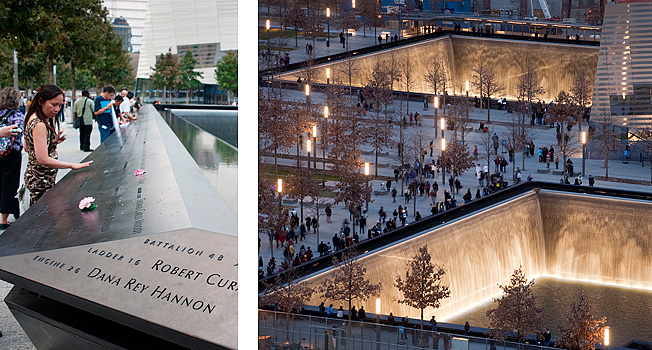
The Pentagon.
At the Pentagon, the ruins of the shattered section were cleared away within weeks of the attacks. Workers finished reconstructing the west exterior wall in June 2002. By Sept. 11, 2002, the first anniversary of the terrorist attack, they had finished rebuilding the outer ring of offices that were destroyed in the attack. Reconstruction of all the building’s damaged areas was completed by the end of 2002.
In 2003, Pentagon officials announced the winners of a design competition for a 2-acre (0.8-hectare) memorial to be built near the site of the attack. The chosen design, created by New York architects Julie Beckman and Keith Kaseman, includes 184 benches positioned over small lighted pools and bearing the names of the victims of the attack. The memorial was dedicated on Sept. 11, 2008.
Pennsylvania.
In September 2002, President Bush signed legislation to establish a national memorial at the Pennsylvania crash site of Flight 93. The Flight 93 National Memorial was completed in 2018. It honors the flight’s passengers and crew, who saved lives by preventing the plane from reaching its intended target. The memorial features a tower with 40 metallic wind chimes, symbolizing the passengers and crew who died in the crash. A team of designers led by the Los Angeles architect Paul Murdoch created the plan for the memorial.
